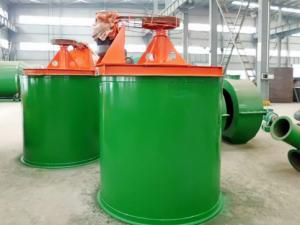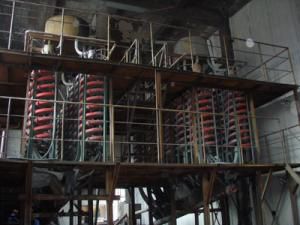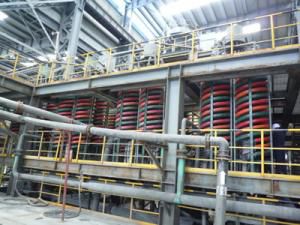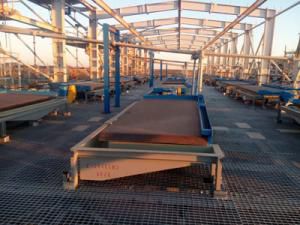The spiral circle of the spiral sorter is usually 3 to 6 circles. After feeding the slurry from the upper end, delamination occurs in the process of flowing along the groove. The high-density particles entering the bottom layer tend to move to the inner edge of the groove, and the small-density particles are thrown out during the rotation of the edge of the spiral separator. After the belt is separated, the heavy objects moving along the inner edge are discharged through the interceptor.
(1) Liquid flow characteristics in spiral groove. There are two kinds of liquid flow in the spiral groove. One is the rotational movement along the longitudinal direction of the spiral groove; The other is spiral groove. The other is the circular motion on the cross section of the spiral groove, also known as the secondary cycle. As shown in the figure, the reason for the secondary circulation is that under the action of centrifugal force, the surface liquid flow has a high speed, and the centrifugal force is large and thrown to the edge of the groove, while the speed of the bottom liquid is low and the centrifugal force is small. It is greatly affected by gravity and tends to move at the inner edge.
When the radius of the groove surface is different, the thickness and average velocity of the water layer are different. The thicker the water layer towards the outer edge, the faster the flow continuity, and the water supply will increase. The wet perimeter will expand outward. With the change of velocity, the flow near the inner edge is almost laminar, while the outer edge is turbulent.
(2) Particles with different densities are sorted in spiral grooves. During the movement of particles with different densities in the slurry in the screw, due to the difference in the size and direction of the force, there are longitudinal and transverse relative movements, so as to realize the separation. The loose stratification process of particles in vortex groove is the same as that in Prajna turbulent slope layer. The clusters of particles move together along the bottom of the slot. At about a circle, high-density particles gradually enter the bottom layer, while low-density particles enter the upper layer. After that, the layering is completed.
After delamination, a lower flow layer dominated by heavy materials and an upper flow layer dominated by light materials are formed. At the same diameter position, the particles in the lower layer are closely packed and in contact with the groove surface. The pressure from the upper layer is large, so the movement resistance is also large. The particles in the upper flow layer are on the contrary, and the motion resistance is small. This increases the velocity difference between the upper and lower flow layers. Small density particles are located in the upper liquid flow with high longitudinal velocity, so they have large inertial centrifugal force. At the same time, the lateral circulation makes them have hydrodynamic effect in the outward direction.
The resultant force of the two exceeds the gravity component and the friction of the particles, so the density particles move to the outer edge of the groove. High density particles have low longitudinal velocity in lower liquid flow, so they have small inertial centrifugal force, while the gravity component and transverse circulation of particles make them have inward hydrodynamic effect. The latter two forces exceed the inertial centrifugal force and friction force of the particles, pushing the high-density particles to move inside the groove and enriching the inner edge area. Other continuous particles with intermediate density occupy the middle area of the groove. The zonal movement lasted approximately until the third and fourth laps.











